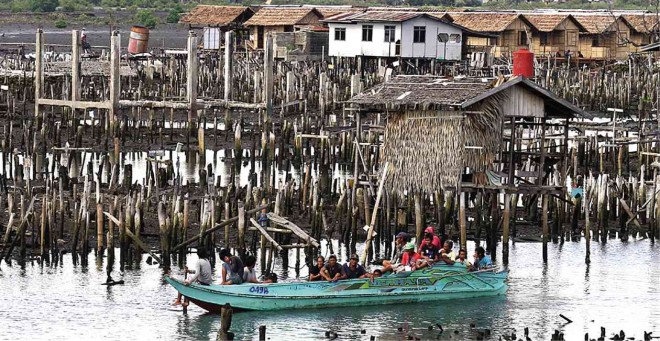ICRC: 40,000 refugees in Zamboanga

A GENERAL view of Barangay Mariki in Zamboanga City where houses were set on fire in last year’s urban gun battle between soldiers and Moro rebels. A year after that incident, thousands of people remain homeless and in need of government assistance. JEOFFREY MAITEM/INQUIRER MINDANAO
A year after the bloody siege in Zamboanga City, the fighting may have stopped but the daily battles of its displaced residents continue.
The International Committee of the Red Cross (ICRC) says 40,000 of the 120,000 persons are still without permanent homes, living in difficult conditions in temporary shelters.
Gareth Gleed, the ICRC delegate in Zamboanga City, lamented the lack of clear, concrete steps toward a durable solution when it came to humanitarian assistance for the residents.
Despite the end of hostilities, which lasted for 20 days in September last year, specific needs of the victims are present a year later.
“A year after the conflict and there has not yet been sufficient investment in providing the displaced community with the opportunity to rebuild their livelihoods, to rebuild their communities. These were needs that were identified in the immediate aftermath of the conflict and remain very present today,” Gleed said in a three-minute video on the ICRC website.
The 40,000 displaced residents live with relatives or in evacuation centers and bunkhouses known as transitional sites.
On Sept. 9, 2013, clashes broke out after a faction of
the Moro National Liberation Front, which tried taking over Zamboanga City, was repelled by government troops.
At least 198 residents were taken hostage and used by the rebels as human shields to aid their escape. The fighting left 208 rebels, 25 government soldiers and 12 civilians dead, with scores injured.
The Department of Social Welfare and Development (DSWD) says the prolonged fighting affected 23,794 families or 118,819 people in 14 villages including Arena Blanco, Cabatangan, Calarian, Canelar, Kasanyangan, Mampang, Mariki, Rio Hondo, San Roque, Santa Barbara, Santa Catalina, Talon-Talon and Zone IV, with massive destruction in eight of 14 villages.
The 20-day siege destroyed 10,160 houses, also creating an economic standstill in Zamboanga City.
In the video, Gleed discussed the ICRC’s efforts to improve the condition of the displaced residents.
The ICRC’s response to the crisis was done in two phases: the first phase was the immediate emergency response while the second phase was the extension of humanitarian assistance during the recovery phase.
Gleed noted that despite such efforts by both the government and other organizations, the displaced residents continue to live in difficult situations.
Water, sanitation
“They have fairly difficult access to water, the sanitation conditions in various evacuation sites and transition sites are fairly poor … We can’t ignore the fact that at the moment, these are very significant needs and these needs will continue to be present until there is a clear direction and concrete steps toward a durable solution,” he pointed out.
He added that the ICRC would continue providing food assistance, nutrition programs, healthcare, clean water, sanitation and other services to the displaced residents.
Earlier, the DSWD said it would move all families still in evacuation centers to transitional sites by December this year.
Social Welfare Secretary Corazon Soliman said Cawa-Cawa Boulevard, for instance, had been free of displaced Sama-Badjao evacuees since Sept. 5.
The evacuees from Cawa-Cawa Boulevard were among 10,402 people from evacuation centers who have been transferred to transitional shelters.
“We are targeting that all families be transferred to transitional shelters by yearend, with the 2,304 remaining families at the grandstand to be moved to safer homes by Dec. 15,” Soliman said.
The transitional shelters are located in Joaquin F. Enriquez Memorial Sports Complex, Tulungatung, Taluksangay, Rio Hondo, Philippine Tuberculosis Society Inc. in Upper Calarian, Mampang, Santa Catalina and Buggoc.
Around 44 families are now living at the Martha Permanent Resettlement site.
In Barangay (village) Tulungatung, a transitional site, for instance, 412 families have been transferred to 25 bunkhouses with 300 rooms built by the DSWD and its partners.
Since the siege, the DSWD has been conducting supplementary feeding programs for children in all transitional sites and evacuation centers, as well as food assistance to displaced families.
The agency said it sent out 553,120 food packs worth
P264 million to evacuees, and even nonfood items like mats, malong and hygiene kits worth P7.6 million.
Livelihood projects such as the cash-for-work program benefited 466 people, who got
P3.8 million for two months’ work. A food-for-work program was also conducted with the World Food Program, in which 18,000 people received 18,000 bags of rice worth P22.5 million.
Psychosocial needs
“The way to recovery is to enable the displaced families to regain their productive capacity,” Soliman stressed.
To help the families start their own businesses, the DSWD provided a P9.7-million capital seed fund to some 970 families at P10,000 each.
To address the psychosocial needs of the evacuees and their children, the DSWD held counseling, stress debriefing and art and play therapy sessions in evacuation centers.
To date, P363.9 million in assistance was given to the displaced families, from the DSWD and its partner organizations.
The assistance also includes transportation allowance for the Balik-Probinsya and Balik Barangay programs.
Like the ICRC, the DSWD noted that although the displaced families are on their way to recovery, much more needs to be done.
Soliman urged for a “real durable solution” to the problem.
“While we have shelter as the temporary answer to the problem of internal displacement, the real durable solution to all of this is peace in Zamboanga City and in the country,” she added.